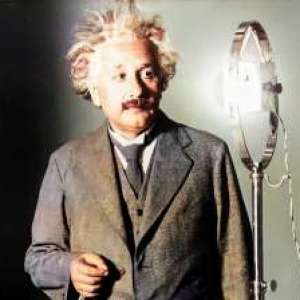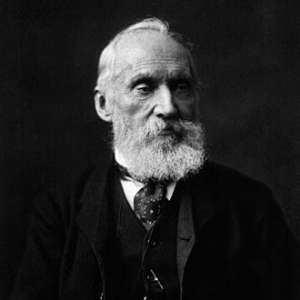
Fundamental ideas and problems of the theory of relativity
Lecture delivered to the Nordic Assembly of Naturalists at Gothenburg* July 11, 1923
If we consider that part of the theory of relativity which may nowadays in a sense be regarded as bona fide scientific knowledge, we note two aspects which have a major bearing on this theory. The whole development of the theory turns on the question of whether there are physically preferred states of motion in Nature (physical relativity problem). Also, concepts and distinctions are only admissible to the extent that observable facts can be assigned to them without ambiguity (stipulation that concepts and distinctions should have meaning). This postulate, pertaining to epistemology, proves to be of fundamental importance. These two aspects become clear when applied to a special case, e.g. to classical mechanics.
Firstly we see that at any point filled with matter there exists a preferred state of motion, namely that of the substance at the point considered. Our problem starts however with the question whether physically preferred states of motion exist in reference to extensive regions. From the viewpoint of classical mechanics the answer is in the affirmative; the physically preferred states of motion from the viewpoint of mechanics are those of the inertial frames. This assertion, in common with the basis of the whole of mechanics as it generally used to be described before the relativity theory, far from meets the above "stipulation of meaning". Motion can only be conceived as the relative motion of bodies. In mechanics, motion relative to the system of coordinates is implied when merely motion is referred to. Nevertheless this interpretation does not comply with the "stipulation of meaning" if the coordinate system is considered as something purely imaginary.

If we turn our attention to experimental physics we see that there the coordinate system is invariably represented by a "practically rigid" body. Furthermore it is assumed that such rigid bodies can be positioned in rest relative to one another in common with the bodies of Euclidian geometry. Insofar as we may think of the rigid measuring body as existing as an object which can be experienced, the "system of coordinates" concept as well as the concept of the motion of matter relative thereto can be accepted in the sense of the "stipulation of meaning". At the same time Euclidian geometry, by this conception, has been adapted to the requirements of the physics of the "stipulation of meaning". The question whether Euclidian geometry is valid becomes physically significant; its validity is assumed in classical physics and also later in the special theory of relativity.
In classical mechanics the inertial frame and time are best defined together by a suitable formulation of the law of inertia: It is possible to fix the time and assign a state of motion to the system of coordinates (inertial frame) such that, with reference to the latter, force-free material points undergo no acceleration; furthermore it is assumed that this time can be measured without disagreement by identical clocks (systems which run down periodically) in any arbitrary state of motion. There are then an infinite number of inertial frames which are in uniform translational motion relative to each other, and hence there is also an infinite number of mutually equivalent, physically preferred states of motion. Time is absolute, i.e.independent of the choice of the particular inertial frame; it is defined by more characteristics than logically necessary, although - as implied by mechanics - this should not lead to contradictions with experience. Note in passing that the logical weakness of this exposition from the point of view of the stipulation of meaning is the lack of an experimental criterion for whether a material point is forcefree or not; therefore the concept of the inertial frame remains rather problematical. This deficiency leads to the general theory of relativity. We shall not consider it for the moment.
The concept of the rigid body (and that of the clock) has a key bearing on the foregoing consideration of the fundamentals of mechanics, a bearing which there is some justification for challenging. The rigid body is only approximately achieved in Nature, not even with desired approximation; this concept does not therefore strictly satisfy the "stipulation of meaning". It is also logically unjustifiable to base all physical consideration on the rigid or solid body and then finally reconstruct that body atomically by means of elementary physical laws which in turn have been determined by means of the rigid measuring body. I am mentioning these deficiencies of method because in the same sense they are also a feature of the relativity theory in the schematic exposition which I am advocating here. Certainly it would be logically more correct to begin with the whole of the laws and to apply the "stipulation of meaning" to this whole first, i.e. to put the unambiguous relation to the world of experience last instead of already fulfilling it in an imperfect form for an artificially isolated part, namely the space-time metric. We are not, however, sufficiently advanced in our knowledge of Nature’s elementary laws to adopt this more perfect method without going out of our depth. At the close of our considerations we shall see that in the most recent studies there is an attempt, based on ideas by Levi-Civita, Weyl, and Eddington, to implement that logically purer method.
It more clearly follows from the above what is implied by "preferred states of motion". They are preferred as regards the laws of Nature. States of motion are preferred when, relative to the formulation of the laws of Nature, coordinate systems within them are distinguished in that with respect to them those laws assume a form preferred by simplicity. According to classical mechanics the states of motion of the inertial frames in this sense are physically preferred. Classical mechanics permits a distinction to be made between (absolutely) unaccelerated and accelerated motions; it also claims that velocities have only a relative existence (dependent on the selection of the inertial frame), while accelerations and rotations have an absolute existence (independent of the selection of the inertial frame). This state of affairs can be expressed thus: According to classical mechanics "velocity relativity" exists, but not "acceleration relativity". After these preliminary considerations we can pass to the actual topic of our contemplations, the relativity theory, by characterizing its development so far in terms of principles.
The special theory of relativity is an adaptation of physical principles to Maxwell-Lorentz electrodynamics. From earlier physics it takes the assumption that Euclidian geometry is valid for the laws governing the position of rigid bodies, the inertial frame and the law of inertia. The postulate of equivalence of inertial frames for the formulation of the laws of Nature is assumed to be valid for the whole of physics (special relativity principle). From Maxwell-Lorentz electrodynamics it takes the postulate of invariance of the velocity of light in a vacuum (light principle).
To harmonize the relativity principle with the light principle, the assumption that an absolute time (agreeing for all inertial frames) exists, had to be abandoned. Thus the hypothesis is abandoned that arbitrarily moved and suitably set identical clocks function in such a way that the times shown by two of them, which meet, agree. A specific time is assigned to each inertial frame; the state of motion and the time of the inertial frame are defined, in accordance with the stipulation of meaning, by the requirement that the light principle should apply to it. The existence of the inertial frame thus defined and the validity of the law of inertia with respect to it are assumed. The time for each inertial frame is measured by identical clocks that are stationary relative to the frame.
The laws of transformation for space coordinates and time for the transition from one inertial frame to another, the Lorentz transformations as they are termed, are unequivocally established by these definitions and the hypotheses concealed in the assumption that they are free from contradiction. Their immediate physical significance lies in the effect of the motion relative to the used inertial frame on the form of rigid bodies (Lorentz contraction) and on the rate of the clocks. According to the special relativity principle the laws of Nature must be covariant relative to Lorentz transformations; the theory thus provides a criterion for general laws of Nature. It leads in particular to a modification of the Newtonian point motion law in which the velocity of light in a vacuum is considered the limiting velocity, and it also leads to the realization that energy and inertial mass are of like nature.
The special relativity theory resulted in appreciable advances. It reconciled mechanics and electrodynamics. It reduced the number of logically independent hypotheses regarding the latter. It enforced the need for a clarification of the fundamental concepts in epistemological terms. It united the momentum and energy principle, and demonstrated the like nature of mass and energy. Yet it was not entirely satisfactory - quite apart from the quantum problems, which all theory so far has been incapable of really solving. In common with classical mechanics the special relativity theory favours certain states of motion - namely those of the inertial frames - to all other states of motion. This was actually more difficult to tolerate than the preference for a single state of motion as in the case of the theory of light with a stationary ether, for this imagined a real reason for the preference, i.e. the light ether. A theory which from the outset prefers no state of motion should appear more satisfactory. Moreover the previously mentioned vagueness in the definition of the inertial frame or in the formulation of the law of inertia raises doubts which obtain their decisive importance, owing to the empirical principle for the equality of the inertial and heavy mass, in the light of the following consideration.
Let K be an inertial frame without a gravitational field, K’ a system of coordinates accelerated uniformly relative to K. The behaviour of material points relative to K’ is the the same as if K’ were an inertial frame in respect of which a homogeneous gravitational field exists. On the basis of the empirically known properties of the gravitational field, the definition of the inertial frame thus proves to be weak. The conclusion is obvious that any arbitrarily moved frame of reference is equivalent to any other for the formulation of the laws of Nature, that there are thus no physically preferred states of motion at all in respect of regions of finite extension (general relativity principle).
Check Einstein Biography
The implementation of this concept necessitates an even more profound modification of the geometric-kinematical principles than the special relativity theory. The Lorentz contraction, which is derived from the latter, leads to the conclusion that with regard to a system K’ arbitrarily moved relative to a (gravity field free) inertial frame K, the laws of Euclidian geometry governing the position of rigid (at rest relative to K’) bodies do not apply. Consequently the Cartesian system of coordinates also loses its significance in terms of the stipulation of meaning. Analogous reasoning applies to time; with reference to K’ the time can no longer meaningfully be defined by the indication on identical clocks at rest relative to K’, nor by the law governing the propagation of light. Generalizing, we arrive at the conclusion that gravitational field and metric are only different manifestations of the same physical field.
We arrive at the formal description of this field by the following consideration. For each infinitesimal point-environment in an arbitrary gravitational field a local frame of coordinates can be given for such a state of motion that relative to this local frame no gravitational field exists (local inertial frame). In terms of this inertial frame we may regard the results of the special relativity theory as correct to a first approximation for this infinitesimally small region. There are an infinite number of such local inertial frames at any space-time point; they are associated by Lorentz transformations. These latter are characterised in that they leave invariant the "distance" ds of two infinitely adjacent point events - defined by the equation:

which distance can be measured by means of scales and clocks. For, x, y, z, t represent coordinates and time measured with reference to a local inertial frame.
To describe space-time regions of finite extent arbitrary point coordinates in four dimensions are required which serve no other purpose than to provide an unambiguous designation of the space-time points by four numbers each, x1, x2, x3 and x4, which takes account of the continuity of this fourdimensional manifold (Gaussian coordinates). The mathematical expression of the general relativity principle is then, that the systems of equations expressing the general laws of Nature are equal for all such systems of coordinates. Since the coordinate differentials of the local inertial frame are expressed linearly by the differentials dxv of a Gaussian system of coordinates, when the latter is used, for the distance ds of two events an expression of the form

is obtained. The gµ v which arc continuous functions of xv, determine the metric in the four-dimensional manifold where ds is defined as an (absolute) parameter measurable by means of rigid scales and clocks. These same parameters gµ v however also describe with reference to the Gaussian system of coordinates the gravitational field which we have previously found to be identical with the physical cause of the metric. The case as to the validity of the special relativity theory for finite regions is characterised in that when the system of coordinates is suitably chosen, the values of gµv for finite regions are independent of xv.
In accordance with the general theory of relativity the law of point motion in the pure gravitational field is expressed by the equation for the geodetic line. Actually the geodetic line is the simplest mathematically which in the special case of constant gµ v becomes rectilinear. Here therefore we are confronted with the transfer of Galileo’s law of inertia to the general theory of relativity.
In mathematical terms the search for the field equations amounts to ascertaining the simplest generally covariant differential equations to which the gravitational potentials gµ v can be subjected. By definition these equations should not contain higher derivatives of gµ v with respect to xv than the second, and these only linearly, which condition reveals these equations to be a logical transfer of the Poisson field equation of the Newtonian theory of gravity to the general theory of relativity.
The considerations mentioned led to the theory of gravity which yields the Newtonian theory as a first approximation and furthermore it yields the motion of the perihelion of Mercury, the deflection of light by the sun, and the red shift of spectral lines in agreement with experience (As regards the red shift, the agreement with experience is not yet completely assured, however).
To complete the basis of the general theory of relativity, the electromagnetic field must still be introduced into it which, according to our present conviction, is also the material from which we must build up the elementary structures of matter. The Maxwellian field equations can readily be adopted into the general theory of relativity. This is a completely unambiguous adoption provided it is assumed that the equations contain no differential quotients of gµ v higher than the first, and that in the customary Maxwellian form they apply in the local inertial frame. It is also easily possible to supplement the gravitational field equations by electromagnetic terms in a manner specified by the Maxwellian equations so that they contain the gravitational effect of the electromagnetic field.
These field equations have not provided a theory of matter. To incorporate the field generating effect of ponderable masses in the theory, matter had therefore (as in classical physics) to be introduced into the theory in an approximate, phenomenological representation.
And that exhausts the direct consequences of the relativity principle. I shall turn to those problems which are related to the development which I have traced. Already Newton recognized that the law of inertia is unsatisfactory in a context so far unmentioned in this exposition, namely that it gives no real cause for the special physical position of the states of motion of the inertial frames relative to all other states of motion. It makes the observable material bodies responsible for the gravitational behaviour of a material point, yet indicates no material cause for the inertial behaviour of the material point but devises the cause for it (absolute space or inertial ether). This is not logically inadmissible although it is unsatisfactory. For this reason E. Mach demanded a modification of the law of inertia in the sense that the inertia should be interpreted as an acceleration resistance of the bodies against one another and not against "space". This interpretation governs the expectation that accelerated bodies have concordant accelerating action in the same sense on other bodies (acceleration induction).
This interpretation is even more plausible according to general relativity which eliminates the distinction between inertial and gravitational effects. It amounts to stipulating that, apart from the arbitrariness governed by the free choice of coordinates, the gµ v -field shall be completely determined by the matter. Mach’s stipulation is favoured in general relativity by the circumstance that acceleration induction in accordance with the gravitational field equations really exists, although of such slight intensity that direct detection by mechanical experiments is out of the question.
Mach’s stipulation can be accounted for in the general theory of relativity by regarding the world in spatial terms as finite and self-contained. This hypothesis also makes it possible to assume the mean density of matter in the world as finite, whereas in a spatially infinite (quasi-Euclidian) world it should disappear. It cannot, however, be concealed that to satisfy Mach’s postulate in the manner referred to a term with no experimental basis whatsoever must be introduced into the field equations, which term logically is in no way determined by the other terms in the equations. For this reason this solution of the "cosmological problem" will not be completely satisfactory for the time being.
A second problem which at present is the subject of lively interest is the identity between the gravitational field and the electromagnetic field. The mind striving after unification of the theory cannot be satisfied that two fields should exist which, by their nature, are quite independent. A mathematically unified field theory is sought in which the gravitational field and the electromagnetic field are interpreted only as different components or manifestations of the same uniform field, the field equations where possible no longer consisting of logically mutually independent summands.
The gravitational theory, considered in terms of mathematical formalism, i.e. Riemannian geometry, should be generalized so that it includes the laws of the electromagnetic field. Unfortunately we are unable here to base ourselves on empirical facts as when deriving the gravitational theory (equality of the inertial and heavy mass), but we are restricted to the criterion of mathematical simplicity which is not free from arbitrariness. The attempt which at present appears the most successful is that, based on the ideas of LeviCivita, Weyl and Eddington, to replace Riemannian metric geometry by the more general theory of affine correlation.
The characteristic assumption of Riemannian geometry is the attribution to two infinitely adjacent points of a "distance" ds, the square of which is a homogeneous second order function of the coordinate differentials. It follows from this that (apart from certain conditions of reality) Euclidian geometry is valid in any infinitely small region. Hence to every line element (or vector) at a point P is assigned a parallel and equal line element (or vector) through any given infinitesimally adjacent point P’ (affine correlation). Riemannian metric determines an affine correlation. Conversely, however, when an affine correlation (law of infinitesimal parallel displacement) is mathematically given, generally no Riemannian metric determination exists from which it can be derived.
The most important concept of Riemannian geometry, "space curvature", on which the gravitational equations are also based, is based exclusively on the "affine correlation". If one is given in a continuum, without first proceeding from a metric, it constitutes a generalization of Riemannian geometry but which still retains the most important derived parameters. By seeking the simplest differential equations which can be obeyed by an affine correlation there is reason to hope that a generalization of the gravitation equations will be found which includes the laws of the electromagnetic field. This hope has in fact been fulfilled although I do not know whether the formal connection so derived can really be regarded as an enrichment of physics as long as it does not yield any new physical connections. In particular a field theory can, to my mind, only be satisfactory when it permits the elementary electrical bodies to be represented as solutions free from singularities.
Moreover it should not be forgotten that a theory relating to the elementary electrical structures is inseparable from the quantum theory problems. So far also relativity theory has proved ineffectual in relation to this most profound physical problem of the present time. Should the form of the general equations some day, by the solution of the quantum problem, undergo a change however profound, even if there is a complete change in the parameters by means of which we represent the elementary process, the relativity principle will not be relinquished and the laws previously derived therefrom will at least retain their significance as limiting laws.
Albert Einstein – Nobel Lecture. NobelPrize.org. Nobel Media AB 2020. Tue. 20 Oct 2020. <https://www.nobelprize.org/prizes/physics/1921/einstein/lecture/>










































